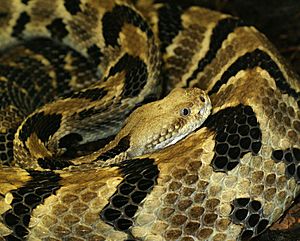Pit vipers facts for kids
Quick facts for kids Pit vipers |
|
|---|---|
 |
|
| Timber rattlesnake, Crotalus horridus | |
| Scientific classification |
|
| Kingdom: | Animalia |
| Phylum: | Chordata |
| Class: | Reptilia |
| Order: | Squamata |
| Suborder: | Serpentes |
| Family: | Viperidae |
| Subfamily: | Crotalinae Oppel, 1811 |
| Synonyms | |
|
|
Pit vipers, also called crotaline snakes, are a group of venomous vipers. They are found in Asia and the Americas.
There are many different kinds of pit vipers. Scientists have found 18 main groups (called genera) and 151 different species. About 7 groups and 54 species live in the Old World (Asia and Europe). The other 11 groups and 97 species live in the New World (the Americas). Pit vipers are the only vipers found in the Americas. Some well-known pit vipers include rattlesnakes, lanceheads, and Asian pitvipers.
Contents
What Pit Vipers Look Like
Pit vipers come in many sizes. The smallest is the hump-nosed viper, which is about 30–45 centimetres (12–18 in) long. The largest is the South American bushmaster, which can grow up to 3.65 metres (12.0 ft) long. This makes it the longest venomous snake in the New World.
Some pit vipers live in trees (they are arboreal). Others live on the ground (they are terrestrial). One special kind, the cottonmouth, even spends time in the water (it is semi-aquatic).
Where Pit Vipers Live
This group of snakes lives in many places around the world. In Europe and Asia, they are found from eastern Europe all the way to Japan, Taiwan, Indonesia, India, Nepal, and Sri Lanka.
In the Americas, they live from southern Canada down through Central America to southern South America. You can find pit vipers in many different habitats, from dry deserts to wet rainforests.
Pit Viper Reproduction
Most pit vipers are viviparous. This means the female snakes give birth to live young, instead of laying eggs.
However, some pit vipers are oviparous, meaning they lay eggs. It is believed that these egg-laying pit vipers guard their eggs to keep them safe. Many young pit vipers have tails that are brightly colored and look different from the rest of their body.
Types of Pit Vipers
Here are some of the different groups (genera) of pit vipers:
- Moccasins (Agkistrodon)
- Jumping pitvipers (Atropoides)
- Palm-pitvipers (Bothriechis)
- Forest-pitvipers (Bothriopsis)
- Lanceheads (Bothrops)
- Malayan pitviper (Calloselasma)
- Montane pitvipers (Cerrophidion)
- Rattlesnakes (Crotalus)
- Hundred-pace pitviper (Deinagkistrodon)
- Asian moccasins (Gloydius)
- Hump-nosed pit vipers (Hypnale)
- Bushmasters (Lachesis)
- Mexican horned pitvipers (Ophryacus)
- Mountain pit vipers (Ovophis)
- Hognose pit vipers (Porthidium)
- Ground rattlesnakes (Sistrurus)
- Asian lanceheads (Trimeresurus)
- Temple vipers (Tropidolaemus)
See also
 In Spanish: Crotalinos para niños
In Spanish: Crotalinos para niños

